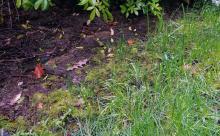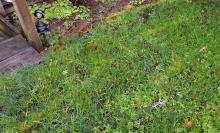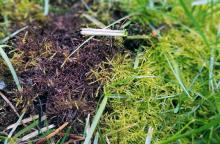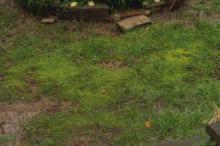See:
Algae, Lichens, and Mosses on Plants
Cause Moss is a primitive plant that can be a weed in turf. Moss is enhanced by human activity, especially by closely mowing in late fall, which chops up the plants and distributes fragments over the lawn. The most common moss found in lawns and gardens in Corvallis, OR was Eurhynchium praelongum and Scleropodium touretii. Brachythecium species are also found in home lawns but rare in putting greens; Bryum spp. are important in greens. Many other species also can grow and become weedy. Although moss often is associated with moist, shady sites, there are species adapted to many different environments including dry, open sites. Mosses need contact with moisture to grow but can survive in a desiccated state for long periods. If a healthy turf stand cannot be maintained at a site, the moss will continue to be a problem. No amount of moss killer will change this.
Symptoms When moss first colonizes an area, it produces a black slimy mat across the area before the green vegetative structures form. The green structures are composed of branch-like filaments called protonema and are easily confused with algae. These then bud out and give rise to more familiar green structures. Mosses can take many shapes and forms. Stems and leaves are complex with conducting strands, midribs, and a great diversity of cell forms. Leaves may be grouped in pairs, threes, and even sets of five.
Eurhynchium praelongum is a regularly to irregularly branching, sprawling moss of light- to dark-green color.
Scleropodium touretii has cylindrical (julaceous), spreading branches that form low mats. It is usually found on soil, which are dry during part of the year.
Bryum argentium is found on open sites and has a silvery appearance. B. lisae colonies are green to yellow-green tufts or clumps.
Cultural control The most successful long-term strategy for moss control is to grow grass that out-competes the moss. Excessive moisture must be eliminated and the proper species of grass must be planted in the problem areas. Maintaining grass, by proper watering and fertilization to promote growth, helps to exclude the moss.
- Ensure good drainage through aeration, installation of drainage, and/or sand topdressing.
- Control thatch to promote good rooting of turf plants and to enhance drainage.
- Maintain soil pH between 5.8 and 6.6 and provide adequate nutrition with a balanced fertilizer program. Fertilize golf greens with 0.5 lb N/1,000 sq ft per month. Increase K to 0.6 lb/1,000 sq ft per month, and apply 0.1 to 0.2 lb iron/1,000 sq ft per month.
- Provide good air circulation and adequate sunlight by pruning nearby trees and shrubs.
- Do not overwater turf. Be sure to irrigate sufficiently during the dry season to promote growth.
- Mow turf at the correct cutting height for the species of grass grown.
- Try to remove moss by hand or by power-raking. Reseed with a grass species more suited to the site. For shady sites, try Poa trivialis, colonial bentgrass, or annual bluegrass. Fine and tall fescues have marginal shade tolerance, and Kentucky bluegrass and perennial ryegrasses have poor shade tolerance.
- Consider alternatives to turf if good conditions for turf growth cannot be met.
Chemical control These must be used in conjunction with the cultural controls above for successful control. Dethatch first and then apply these products so you get good uniform coverage.
- Bonide MossMax (potassium laurate) is registered for roofs as well as lawns. H
- Cinnerate at 16 to 50 fl oz/100 gal water plus an adjuvant. No reentry listed. O
- QuickSilver at 6.7 fl oz/A followed by a second application 2 weeks later. Reentry when sprays have dried.
- Treat with ferrous sulfate applied to dampened plant surface when moss is growing most actively. For best results, remove as much moss as possible by hand or by power-raking before treatment. Turfgrass temporarily darkens for 1 week after treatment. Sidewalks and driveways are permanently stained by these materials.
- Bonide MossMax at 4 lb/1,000 sq ft. Washington only. H
- Lilly Miller Moss Out! at 2 lb/400 to 500 sq ft. H
- Moss Terminator 10-0-6 at 3 to 10 lb/1,000 sq ft. H
Note: Copper-based pesticides used to be registered for moss control but only algae control may be left on some labels. Straight copper sulfate and copper soaps are phytotoxic to turf. Fixed coppers may induce an iron chlorosis in some grass species. Copper can build up quickly to toxic levels in the soil, stunting plants, and thus are no longer recommended.
Reference Cook, T., McDonald, B., and Merrifield, K. 2002. Controlling moss in putting greens. Golf Course Management 70:103-106.





